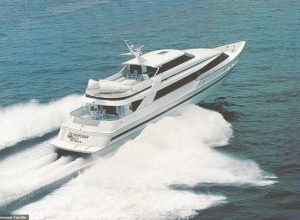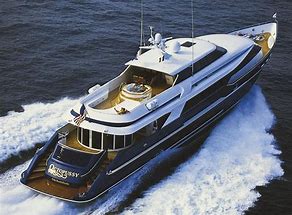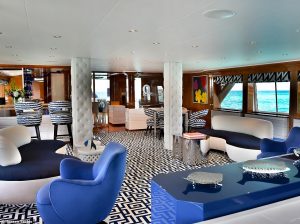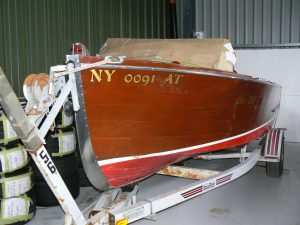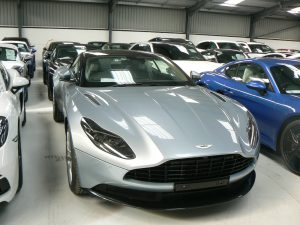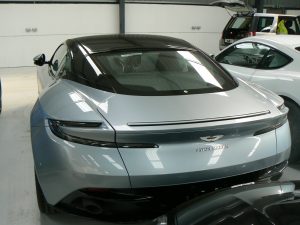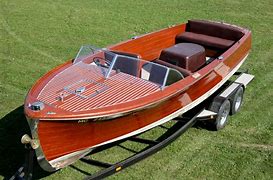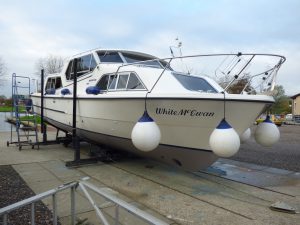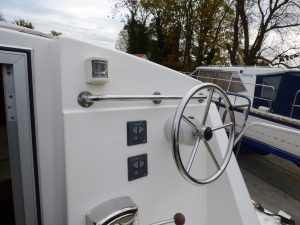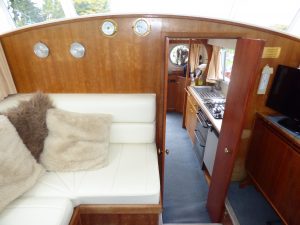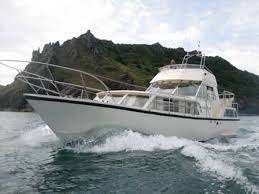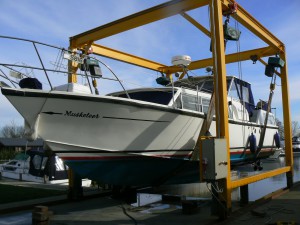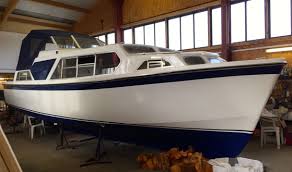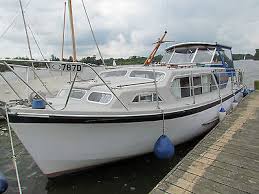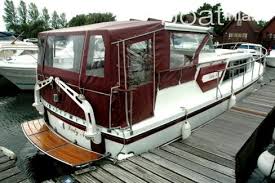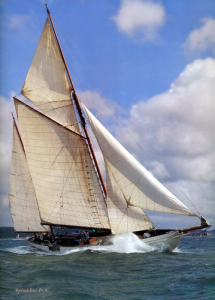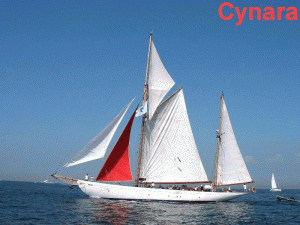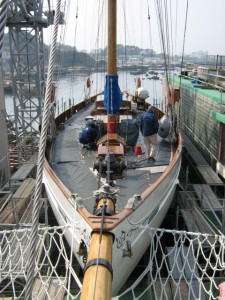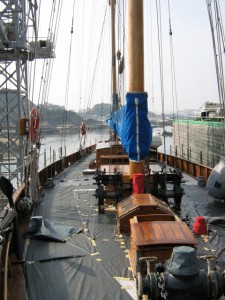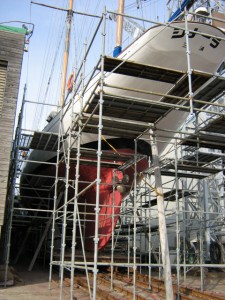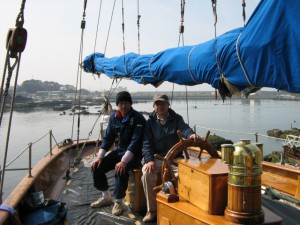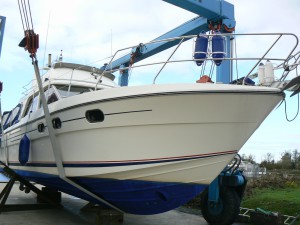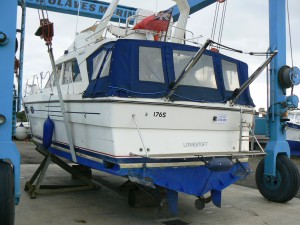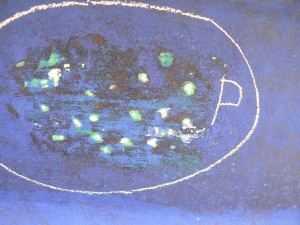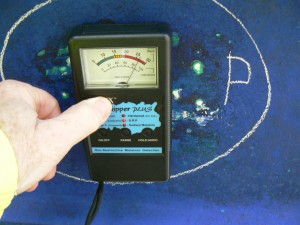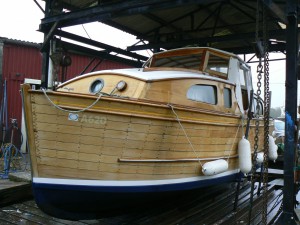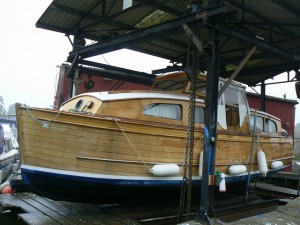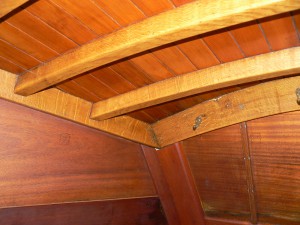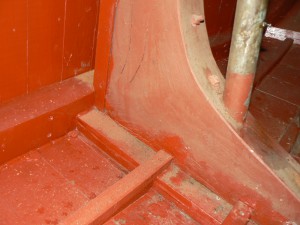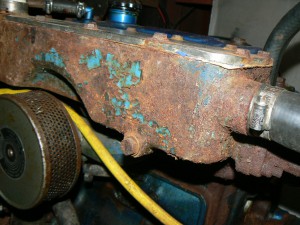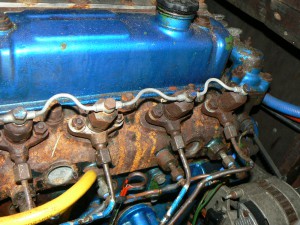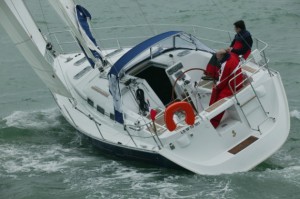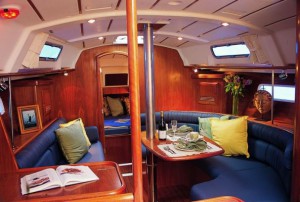‘Octopussy’ – The Superyacht that couldn’t be builtApril 29, 2020
When American entrepreneur, John Staluppi, decided in the early 1980s that he wanted the fastest superyacht in the world – one that could break the 50 knot (57.5mph) barrier – every boatyard told him it couldn’t be done. Every boatyard except Heesen Yachts in the Netherlands.
It rose to the challenge in spectacular style, delivering Octopussy in 1988 – a boat the size of a small house that was actually capable of a world-record-beating 53.17 knots (61mph). And now a new documentary has revealed the fascinating story behind this remarkable feat of engineering, according to the Daily Mail.
Called Octopussy: The Yacht That Could Not Be Built, it tells how Staluppi, after investigating the highest horsepower engines available, took the unprecedented step of buying three immensely powerful MTU power units and went looking for a naval architect to design a boat around them. But it was an order too tall for everyone he approached.
He says in the documentary: “I could never have the biggest yacht in the world, but I knew that I could have the fastest yacht in the world. [But] some people [I approached] would look at it and go back to engineering departments then come back and say ‘it’s impossible’.”
However, Frank Mulder of Mulder Design, a skilled naval architect from the Netherlands, after six weeks of calculations, said the project was possible.
Staluppi continues: “Mulder said that he only knew one shipyard that might take the challenge. And that’s how we got started with Frans Heesen, who was supposed to be the best.”
Staluppi continues: “Mulder said that he only knew one shipyard that might take the challenge. And that’s how we got started with Frans Heesen, who was supposed to be the best.”
Shortly after, in a meeting in Fort Lauderdale, Heesen accepted Staluppi’s challenge to build the fastest superyacht in the world.
In an age before computers, he was the first to say that ‘if he [Mulder] comes up with the right drawings and calculations… then I will build you this boat’.
The documentary reveals that Heesen was so supremely confident in his team’s engineering and craftsmanship, he even agreed to a legally binding penalty clause in the contract that if Octopussy did not reach 48 knots (55mph) at launch, Staluppi would not have to take the boat or pay for the cost.
In addition, for every knot under 50 that the top speed equalled, the shipyard would have to pay Staluppi $100,000 (£80,000). That’s the equivalent of $200,000 (£160,000) in today’s money.
However, for every knot over 50, Heesen Yachts would receive a $200,000 bonus ($430k/£345k in today’s money).
Staluppi says: “It was a risky challenge for a shipyard – if it went under 48 knots, I didn’t have to take the boat and they’d give me all my money back.
“So, I bought a radar gun. And he [Frans Heesen] said ‘OK, we can do it’.”
Financially the yard could not survive such a loss, but the documentary shows that with the international press following Staluppi’s every move, an ambitious Heesen decided to risk the entire future of the company for the opportunity to put the shipyard’s name on the global stage.
From then, each decision, from the water jets specified to the appliances that Staluppi’s wife, Jeanette, chose were defined by weight.
All parties worked around the clock to ensure the boat was as light as possible to facilitate hitting the 50knot goal.
When it was launched in April 1988, Octopussy not only looked sleeker than any other yacht at the time with its futuristic design, but exceeded all expectations with its astounding top speed of 53.17 knots (61mph).
The gamble had paid off. Staluppi realised his dream and Heesen Yachts became an international sensation.
In 2015, Octopussy underwent a refit with the length extended to 44m (144ft), while New York designer, Jeff Lincoln, updated its interior in a manner which no Bond villain, ever, could bear to be seen in.
Acknowledgement to Marine Industry News
For more information contact European Marine Services Ltd.
Marine Surveyors & Consultants | ADR Mediation | Expert Witness
www.europeanmarinesurveys.com
Tel: (44) 01603 327 123
Chris-Craft Sportsman 22 – A Renovation Project #01365March 17, 2018
We recently undertook a Condition Inspection on a 1941 Chris-Craft 22 Sportsman, recently brought into the UK from the USA.
As can be imagined this classic launch is now in need of some renovation but the mahogany construction is basically sound and the Grey Marine 90hp four cylinder petrol engine will require a complete overhaul. The Chris-Craft Sportsman is regarded as the American rival to the Italian Classic Riva and this Sportsman 22 was still being used until quite recently.
When inspected we were surprised and delighted to find this 1941 Chris-Craft to be in very very good company being ‘surrounded’ by literally dozens of new supercars to include Aston Martins, Porsches and Ferraris to name just a few
How about this ………. we’ll leave you to decide the model
Chris-Craft ‘A Potted History’
Chris Smith built his first wooden boat in 1874 at the age of 13.[1] Years later, he built a duck hunting boat. His friends liked the way he built them, and they asked him to build them one. This was technically the start of the boat company. He soon began to build more boats and joined his brother Hank in 1881 to begin producing boats full-time.
In 1910, the brothers joined with other partners to form the Smith Ryan Boat Company.[1] The firm’s name was changed in 1922 to Chris Smith & Sons Boat Company, then to Chris-Craft in 1924. The Detroit-area company became well known for its sleek racing boats in the 1910s and 1920s. Chris-Craft sold high-end powerboats to wealthy patrons such as Henry Ford and William Randolph Hearst.
In the late 1920s, Chris-Craft extended its market into the middle class when it became one of the first mass-producers of civilian pleasure boats. The company began assembly line production at their plant in Algonac, Michigan,[2] dramatically lowering production costs. Formerly, most powerboats had been hand-built. Engines were supplied by both Ford and Chrysler, and by the Hercules Engine Company in later models.[3]
After the war, Chris-Craft introduced a new lineup of civilian pleasure boats in time for the massive American consumer expansion of the 1950s. That decade marked the height of company prestige, and the Chris-Craft brand name became virtually synonymous with pleasure boating. The company offered 159 different models, and it was the sales leader in many categories of small civilian powerboats.
The company sold high-end boats to famous customers such as Dean Martin, Katharine Hepburn, Frank Sinatra, and Elvis Presley. Their boats were often made from the finest mahogany and were considered to be among the best available. They were easy to operate, a must for their “weekend sailor” owners. In some circles, owning a Chris-Craft was considered de rigueur. Even their lower-priced boats were considered to be of high quality, often featuring such luxurious items as a liberal use of mahogany, teak, and brass.
WW2
Chris Smith died in 1939, but his son Jay proved to be an equally able builder of boats and the company continued to flourish. Contributing to the war effort, Chris-Craft built more than 10,000 landing craft. On June 6th, 1944, Chris-Craft LCPLS spearheaded the D-Day landings. To this day, Chris-Craft remains the only recreational boat manufacturer to have its boats tested under fire.
After World War II, Chris-Craft recommenced commercial boat production with renewed vigor. By 1959, Chris-Craft had 10 factories and more than 5,000 employees. Leadership of the company passed to Chris Smith’s grandson, Harsen. When interviewed by Time magazine, he attributed Chris-Craft’s success to the family rather than any individual within it.
Footnote
We have introduced the owner to two local boat building companies we consider capable of undertaking high quality renovation, so hopefully this Classic Chris-Craft 22 Sportsman will remain local
For more information contact European Marine Services Ltd. Marine Surveyors & Consultants
EMS also undertake Boat Safety Inspections & Engine Inspections
www.europeanmarinesurveys.com
Tel: 01603 327 123
Sheerline 950 | A very nice inland waterway vessel # 01346November 21, 2017
SHEERLINE 950 Centre Cockpit Built By: Wroxham Marine, Norwich in c 2000 and despite being some 17 years old is still very well presented being fitted with a single Nanni diesel engine on conventional drive propulsion
We were made very welcome and carried out the Pre Purchase Survey at the Ouse Valley River Club (OVRC) St Neots, being a very nice and well positioned marina and boat club with a private slipway
From the OVRC website:
Welcome to Ouse Valley River Club – We are a private members motor boat club founded in 1950’s based on the River Great Ouse in St Neots, Cambridgeshire. Founded over 60 years ago, the OVRC has gone from strength to strength and today our members enjoy fantastic boating facilities that rival the best proprietary marinas. This includes a large Clubhouse with a bar, showers and toilets and an excellent slipway, all set in a secure and beautifully maintained four and a half acre marina.
The Sheerline 950 centre cockpit styling is very popular on the inland waterways with easy stern access from the aft well, reasonable decks and very comfortable accommodation. Many of these boats have been built for the hire boat industry and have proven to be a very popular over the past 25 years. This example has remained in private hands since it was built and benefits from having both a bow & stern thruster as well as a second steering position on the stern.
This aft steering position is unusual and we believe the only Sheerline with such an option
This Sheerline is well built and despite her age and being currently moored in fresh water, exhibited no signs of osmosis – which to say the least is unusual
Sheerline 950 Accommodation
Inside, the accommodation is well presented. Entering the vessel from the stern you step into a well laid out galley / living area which makes into a double berth. You then step up into the wheelhouse / saloon area which has a full sliding roof allowing you access onto the decks. Moving further forward you then have a reasonable sized WC and forward cabin and a further 2 berth accommodation to the bow. The whole accommodation area is both light and airy with good visibility of the world going by on the outside.
The decks are reasonably wide for a vessel of this size which does not appear to affect the accommodation size inside.
This was a very well presented vessel which over the past 17 years had been well maintained.
On this Sheerline 950 Centre Cockpit the following items required attention:
- Propulsion System: Worn Cutlass Bearing.
- Fire & Safety: Service Fire Extinguishers.
- LPG System: Carry out a LPG Soundness Test.
For more information contact European Marine Services Ltd. Marine Surveyors & Consultants
EMS also undertake Boat Safety Inspections & Engine Inspections
www.europeanmarinesurveys.com
Tel: 01603 327 123
Moonraker 360 – An icon from the past (# 01011)February 15, 2016
We recently undertook a PPI (Pre Purchase Inspection) of a Colin Chapman / JCL Marine 1972 Moonraker 360, which was in some ways like going back in time – A Blast from the Past
For those of you whom are interested, and to give some idea as to the background of Moonraker Marine / JCL / Colin Chapman & Lotus Cars we have reproduced the below history from www.moonrakerboats.com and acknowledge them accordingly ………..
History 1967 – 1980 In 1967 a German Rhine Army captain died before he could take delivery of ‘Moonraker’ a boat he had commissioned from Vic Bell at Brundall, Norfolk to build and fit out. The 30′ boat named ‘Moonraker’ by the buyer was an Ocean 30 (built by Aquafibre) and fitted out by Bell’s family firm – still in existence today and run by Vic’s son John Bell. The German executors asked Vic Bell to sell the boat on their behalf – the name ‘Moonraker’ was kept and the boat sold to a David Buxton.
David Buxton – a car dealer and semi-amateur racer – had been brought to Norfolk, visiting John Berry, as part of his connection with Colin Chapman & Lotus cars. Buxton changed the interior of the boat – adding a stereo and cocktail cabinet, but quickly tiring of cruising on the Norfolk Broads decided to sell Moonraker.
It was the ensuing interest in the boat and the profit he made that spurred him to set up with Vic Bell at Brundall to build six more Moonraker 30’s – without flybridge at this stage.
Having found a thriving market, it was decided to build a bigger model. Naval architect Robert Tucker (for a while he was also a Moonraker company director) designed the 36 foot Moonraker.
Despite the popularity and good sales of the Moonraker 36, the company had financial difficulties and John Berry persuaded Colin Chapman to buy the company, which he did in 1971. Lotus managers and engineers transformed the company and marketing infra-structure as well as making revolutionary changes in design and manufacturing. There was a great cross over of staff and technology between marine & automotive design and production.

Under Colin Chapman the company acquired JCL Marine and expanded the range of boats built. With Don Shead the Marauder was designed and built. Then came the so called ‘Mediterranean Models’ of Mystere, Mirage, Mamba, Mistral and the uncompleted Mangusta project.
After the company went into voluntary liquidation in October 1980, the half finished Moonraker hulls were bought by Waveney Lakes. The Moonraker moulds were bought by DC Marine who built the marque under the name Moonraker ‘Super 36’. Vic Bell bought the moulds back in 1990 and built one more Moonraker before leaving the moulds to stand on the Brundall site.
Although the Mystere / Mirage moulds were bought by Tamaris Marine – the company folded without producing any further boats.
The Mamba mould tools were sold on and at least one model produced under the ‘Falcon’ label. The Marauder plans along with the ‘Streaker’ (adapted Mamba open sports model) were sold to a company trading as Cleopatra Ltd.
We believe that the Moonraker 36 mould tools are still at Bell Boats Marina, Brundall – are they waiting for another chapter to open ?
Moonraker Models
As well as the 3 main types of Moonraker available (Sedan, Cruiser and Sports Yacht, with many variations of these also available) from 1972, coloured hulls were also available, the first being yellow. The ‘D’ series was introduced in 1973, which extended the forward cabin windows so giving greater head/standing room.
In August 1975, JCL / Moonraker Marine International Ltd became the first boatyard in the country to hold the Lloyd’s Register of Shipping Quality Control certificate. In 1976, the Moonraker 36 was the first boat to comply with and receive Lloyd’s Register Building Certificate (L.R.B.C.).
The exact numbers of Moonrakers built and sold by Moonraker/JCL between July 1971 and voluntary liquidation in 1980 are not available. Many records were destroyed when the Brundall Gardens office was hit by lightening on 15th August 1993, however surviving records show that by April 1979, 384 Moonrakers had been built and sold.
Post liquidation some half finished moulds were completed by Waveney Lakes. DC Marine then bought the moulds and competed approximately six Moonraker ‘Super’ 36. This had a much updated interior, 2 x 175hp Perkins Diesel engines and some exterior styling changes.
Vic Bell then again acquired the mould and in 1991 commissioned Excel Marine to build a Moonraker for his own use. Although planning to use this for a demonstrator for further builds, these did not happen and the Moonraker moulds remain at the Bells yard site.
For more information contact European Marine Services Ltd. Marine Surveyors & Consultants
Tel : 01603 327 123 www.europeanmarinesurveys.com
Ocean 30 – An unexpected recent build (#988)December 2, 2015
The Ocean 30 also built as the Moonraker 30, were built mainly between 1968 – c 1980 and therefore to conduct a pre-purchase survey on a boat reportedly built early 1991 is unexpected – However the date appears to check out as the engine number is c 1990
The moulding was by AquaFibre of Rackheath, the semi-displacement round bilge with a long central box keel design by John Bennett – the vessel being rated as an extremely good sea boat.
Herbert Woods of Potter Heigham were the predominant fitters-out until 1975, plus Broom Boats of Brundall and RA Nunn after that. Between 1968 – 1970 Bell Buxton produced the Moonraker 30 based on the Ocean hull. Over 1,000 Ocean 30’s were built. Most can be found on inland waterways but these boats are quite capable of going to sea.
The boat we inspected was an aft cockpit version with a bathing platform, davits, single diesel engine with twin bilge keels – again unusual. An aft cabin version was also produced mainly as a hire boat but the usable deck space (and aft cabin space) in this version is somewhat limited
On our Ocean 30 the following items required attention:
Fuel tank access / piping conformity Auto bilge pump operation
Recommend the LPG water heater installation is checked by a qualified engineer
For more information contact European Marine Services Ltd – Marine Surveyors & Consultants Tel : 01603 327 123 www.europeanmarinesurveys.com
Gaff Rigged Wood Ketch ‘Cynara’ – Marine Survey in Japan (# 00159-07)December 1, 2015
Japan – A long way to go for a Marine (Insurance) Survey, but a great adventure & experience
Several years ago back in 2007 we had the pleasure and honour to be instructed by a large Japanese Corporation to undertake a Condition Survey / Valuation of this most famous 110′ gaff rigged ketch built in 1927 by Camper & Nicholsons UK. (Launched as ‘Gwendolen’) We therefore thought that this condition / valuation survey would make an interesting blog
Dimensions: Auxilliary Gaff Rigged Ketch ‘Cynara’ LOA 109′ 8″ x Beam 18′ 7″ x Draft 11′ 3″
Rumour is that ‘Cynara’ belonged at one time to Winston Churchill. The Cynara itself doesn’t have a log. It also doesn’t have a certificate to prove Churchill’s ownership. However the Japanese owner’s believe this to be true
During her early years she was owned by Lord Northampton, her longest owner to date, and was later used for charter in the Mediterranean where she entertained the likes of Prince William of Gloucester. Another of her accolades involves the film industry where Cynara starred in the film, Arriverderci Baby ! with Tony Curtis and Zsa Zsa Gabor.
Cynara (73.4 tons) was sailed to Japan in 1973 to become a promotional tool for ‘Seibu’, a Japanese department store. Cooking classes were held on ‘Seibu’s luxury yacht’ as part of the companies’ ‘edutainment concept’ and she regularly went out on sunset cruises. During this time her devoted skipper took serious pride over the maintenance of the vessel, especially when it came to his varnish!
View aft standing on bow sprit Deck view View from beneath with a 11′ 3″ draft
Japan (Tokyo) is a long way to go to undertake a condition survey & market valuation, plus travelling south to Kanagawa (marina) which took a day by car, but had the pleasure of the bullet train ride back to Tokyo – a very rewarding experience
If anyone wants to know what it is like staying in a local Japanese hotel with communal bathing and sleeping on a mat on the floor plus eating ‘real’ Japanese food, don’t ask.
Plan of Cynara
For more information contact European Marine Services Ltd – Marine Surveyors & Consultants Tel : 01603 327 123 www.europeanmarinesurveys.com
Princess 35 – A lot of boat for the price (#969)November 22, 2015
A recent pre purchase survey on a 1985 Princess 35 powered by twin Volvo Penta 165hp diesel engines, showed us that you can buy a ‘lot of boat’ for a budget price
This Princess 35 is an estuary / coastal GRP motor cruiser with twin inboard diesel engines and standard shaft propulsion. The hull design is medium V with chines
This marine survey was carried out at St Olaves Marina. Where earlier this year they upgraded their lifting capability with the addition of a 50 tonne travel lift. Being only 1/2 hour from Breydon Water / Gt Yarmouth, St Olaves Marina now offers a readily accessible lifting service to boat owners and passing yachtsmen
As is usual most boats of this vintage that moor on the Norfolk Broads / inland waterways this Princess being no exception, the underwater surfaces will tend to have osmosis. Interestingly boats moored in salt water will (to a much greater extent) tend to not have osmosis.
All GRP structures immersed in water will absorb water through the gel coat, to what extent this happens is dictated by numerous factors. Water temperature, thickness of gel coat, quality of construction, quality of materials, temperature during build, and salinity of the water all have some bearing on the absorbency of your hull.
Visual evidence of osmotic blistering Associated moisture meter readings
Very simply, the problem is caused by water penetrating the gelcoat and entering the laminated structure. This water takes in solution free chemicals salts and becomes denser than salt water on the outside of the hull. This creates a differential pressure and since water will not compress blisters form on the outer side of the gelcoat
Today the presence of osmosis does not cause great concern. If there are blisters but they are small and not too many they are not likely to have any significant effect on the structural strength.
Other than the above osmosis which is considered relatively minor there were not too many negative factors, and at the price paid the new owner is able to bring this Princess 35 up to top specification and enjoy many more years of top quality cruising
In summary the following items required attention:
Raw water seacock valve security Fuel tank piping conformity
Battery storage Auto bilge pump satisfactory operation
For more information contact European Marine Services Ltd – Marine Surveyors & Consultants Tel : 01603 327 123 www.europeanmarinesurveys.com
Moore’s 1950s Wood Classic Cruiser – Still Going Strong (# 00973)
We undertook a pre purchase survey on this ex hire boat ‘classic’ being in private hands for some time and were pleasantly surprised at the results
This 26′ carvel constructed mahogany on oak (ex hire R Moore & Sons (Wroxham) Ltd) built in 1950 and therefore now some 65 years plus of age, is still going strong and in remarkable good structural condition – being an OAP and of ‘retirement’ age
The bottom is heavily tarred which has gone along way to protect the structure and the presentation topsides / superstructure is beautifully varnished giving an overall classic appearance – per original build
The above photos being typical of the build and current condition
To be expected – not everything was in perfect structural condition however, there being some wet rot in bottom planking (not extensive) with wet rot in a bulkhead beneath the side decks. The BMC 1.5L diesel engine and exhaust manifold was heavily corroded -but overall nothing too much and all recoverable
Examples of engine / manifold corrosion present
The interior is typical of this era with (by today’s standards) a very basic rear saloon / cabin / galley area with a settee / double bed and not much else – but this is all part of its charm. A great escape from television and the world of the internet
For more information contact European Marine Services Ltd – Marine Surveyors & Consultants Tel : 01603 327 123 www.europeanmarinesurveys.com
Beneteau Oceanis 323 – A great yacht at a bargain price (#965)October 30, 2015
Boat of the Year – Oslo 2004 ” A Great Charter Yacht “
We recently conducted a pre purchase survey on a Beneteau 323 which was stored ashore at the Titchmarsh Marina, Walton on the Naze, Essex – A beautiful location with stunning views across to Harwich. The sun was also shining making this inspection more pleasurable
The first thing to be said about this Beneteau was the price, being sold at an agreed bargain price of around £15 – £20k less than the selling price she would command on the South Coast.
The Beneteau Oceanis 323 inspected had a fixed fin ballast keel and single rudder as apposed to a lifting keel and twin rudders
The stainless standing rigging was all in good shape although the running rigging could do with being ‘washed’ (in a net bag in the washing machine) as it has been exposed to all weathers.
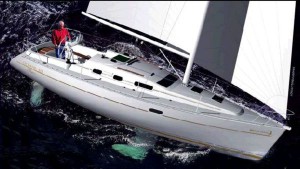 An excellent view of the fin ballast keel and rudder
An excellent view of the fin ballast keel and rudder
As the alloy mast was in position we could only report on the ‘rigging’ etc as seen at deck level. Not being sail makers we do not comment on the sails – and its just not practical to open up large mainsails / foresails for examination other than in a sail loft.
One novel feature that we did not appreciate at the time was that the wheel / helm console in the spacious aft cockpit can be rotated 90 deg fore-aft to allow for easy side passage.
This yacht passed survey with flying colours but one comment is why do manufacturers / boat builders mix mild steel washers with stainless bolts as is the case with the keel bolts !
For more information contact European Marine Services Ltd – Marine Surveyors & Consultants Tel : 01603 327 123 www.europeanmarinesurveys.com
Freeman 22 | Freeman 23 | Freeman 27 | A month of ‘classic’ boat surveysSeptember 9, 2015
This is a month of carrying out Pre Purchase Surveys on the ‘classic’ Freeman Range of inland waterway craft that were built between the 1960s and 1970s and still going well after 50 years
As they say when waiting for bus along come three ……….
” History ” Acknowledgement to the official Freeman Cruisers website
The first 22ft Freeman Cruiser emerged in 1957. By the 1970’s the factory was employing 125 people, building three 23ft and one 26ft cruiser each week and one Freeman 30 every 2/3 weeks. There were 4 or 5 factory lines at a time: It took 25 men to build a single boat. Some 6,000 boats were produced by the time John decided finally to retire, he now lives in France. Incidentally, the last boat to be built was a Freeman 27 in October 1983.
In 1964 the model was changed bringing in the new 22 which is now known as the Mk 2 (hence the previous boat is referred to as the Mk 1). The cabin was raised so that you could walk right through,- the well renowned “step in the deck” was established. As with the 22 Mk 1 there is a narrow beam version of the 22 Mk 2 at 6ft 10″ wide which can also be used on the canals.
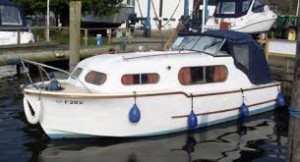 Traditional Freemen 22 with a ‘stepped’ deck
Traditional Freemen 22 with a ‘stepped’ deck
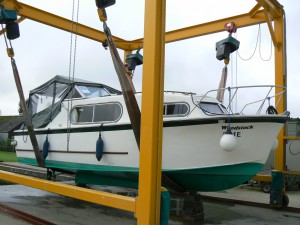 Traditional Freeman 23 with level decks
Traditional Freeman 23 with level decks
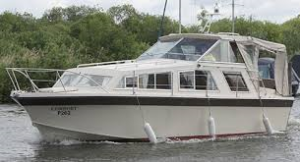 Freeman 27 a radical design change
Freeman 27 a radical design change
A common feature of the earlier Freeman’s design was the flexing of the forward decks due to lack of reinforcement within the GRP such as a balsa core. In both the 22 and 23 this was the reality.
In some earlier models a bolt-on encapsulated wood keel is added for improved steerage so attention must be made to the keel bolt fastenings
Both the smaller models had the historic Ford Watermota inboard four cylinder petrol engine, which were still performing well. However when undergoing a survey particular attention must be made to the petrol system installations to include earth bonding.
For more information contact European Marine Services Ltd. Marine Surveyors & Consultants
EMS also undertake Boat Safety Inspections & Engine Inspections
www.europeanmarinesurveys.com
Tel: 01603 327 123



